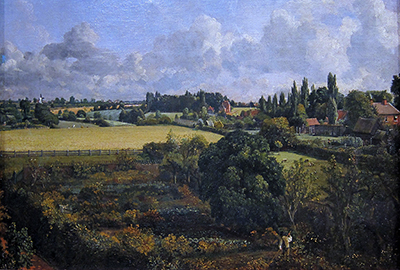This artwork depicting the vegetable garden of John Constable's father Golding was painted during 1815 as a twin of another painting depicting his mother's flower garden. This two paintings, which was never sold during his lifetime, was very personal and reflected the personal world of the artist at their family home in East Bergholt, Suffolk.
Constable used his broad and naturalistic brushstrokes to capture the natural light and the movement of the animals in the fields, the worker at work in the garden, and others in neighbouring gardens. In this work, he displayed his sense of realism and what he saw in front of him, the natural tones and green colours used to resemble the colours found in the countryside. The smoke coming from chimneys in distant houses also brings movement to the painting. The cloud formations filling the upper half of the painting clearly shows Constable's mastery when painting clouds The depiction and interpretation of the landscape show Constable's view that a landscape must be painted to reflect its beauty and not only serve as a background to another object. John Constable used oil on canvas to paint the painting, with its dimensions of 33.4 x 51.5 cm.
The painting features Constable's father, Golding Constable’s Vegetable Garden painted from the upper window of the Constable House on East Bergholt, Suffolk. The painting provides an eye-witness view of the garden and the surrounding landscape with the houses of the village to the right-hand side of the painting. The painting was done after his mother passed away with his father quite ill. The artwork was intended as a twin painting with the painting of his mother's flower garden to form a panorama of the landscape surrounding his childhood home.
The house, garden and surrounding area was also the subject of some of his earliest drawings and sketches with this painting displaying the bond he had with the area which became known as "Constable Country". The artwork and its twin are both housed in Christchurch Mansion located in Ipswich, Suffolk, England as part of the Constable Art collection of the Ipswich Museum. The Christchurch Mansion has owned the painting and its twin since 1955 after Ernest Edward Cook passed away and bequeathed his collection to the National Art Collections Fund.




